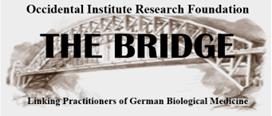Healing for Body, Soul and Spirit
Three years ago OIRF introduced S-Acetylglutathione (SAG) as developed by Dr. med. Gerhard Ohlenschlager to affiliates and members. If you have not been using this therapy for yourself and patients you need to at least investigate its benefits thoroughly.
1) The Body
High dosage replenishment of the tumor specific anti-oxidants Selenium, Vitamin C, reduced glutathione (in the form of SAG), and melatonin (in cases of involvement of the vegetative nervous system and/or hormonal system) has been shown to be effective in both preventing tumors and destroying cancer cells.
Glutathione is a small protein composed of three amino acids: cysteine, glutamic acid, and glycine. Glutathione is involved in detoxification – it binds to toxins, such as heavy metals, solvents, and pesticides, and transforms them into a form that can be excreted in urine or bile. Glutathione is also an important antioxidant. In preliminary research, dietary glutathione intake from fruit and raw vegetables has been associated with protection against some forms of cancer. Glutathione has also inhibited cancer in test tube and animal studies. In preliminary research, higher glutathione levels have also been associated with good health in older adults.
In vitro evidence suggests that reduced glutathione, as well as S-acetylglutathione, can induce apoptosis in several tumor cell lines without influencing growth and viability of normal cells (1).
Curcumin inhibits oxidative damage to DNA and increases the activity of glutathione-S-transferase, an enzyme that binds toxins with glutathione and thereby helps remove them from the body (2).
The isothiocyanates sulforaphane and phenethylisothiocyanate, present in particularly high amounts in broccoli and watercress respectively, have been seen to be potent anti-tumor agents in laboratory and animal studies. They are phase II detoxification inducers, increasing conjugation of carcinogens with a variety of agents to render the carcinogens inactive and increase their clearance from the body. The level of these compounds in cruciferous vegetables varies considerably depending on growing conditions (3).
In a meta-analysis of 12 studies, intake of fruits and vegetables was seen to be consistently and significantly negatively associated with breast cancer risk. Although this relationship was approximately equal in strength to the positive association with saturated fat, the risk-reducing effects of fruit and vegetable intake were not simply attributable to a lower-fat diet. Other studies cited indicate increased risk of breast cancer with decreased intake of vitamin A in women over 55; decreased risk of breast cancer in women ingesting the largest amounts of carotene, vitamin C, and dietary fiber; and a threefold risk of breast cancer in women eating less than seven portions of green vegetables per week, compared with those eating eight or more servings per week (4).
Information from more than 42,000 women indicated that consumption of a diet that most closely approached current dietary guidelines reduced all-cause mortality as well as the risk of breast cancer. Women who reported the highest frequency of consumption of 23 foods such as apples, oranges, broccoli, tomatoes, greens, carrots, baked or stewed poultry, dark breads, high-fiber cereals, and low-fat milk had a risk of all-cause mortality 30% less than that of women who consumed these foods the least frequently. Diversity of diet (consuming five food groups daily compared with two or fewer) also significantly decreased mortality; those with low diversity had a 40% greater risk of death within the study time period (5).
Side-effects:
In some cases treatment with S-AcetylGlutathione can lead to a lack of trace-elements (check plasma selenium and zinc levels) accompanied with a possible lack of magnesium and potassium. In diabetics it can alter the amount of insulin required, so that a regular blood sugar test is required.
How high should the doses be?
This depends on the current lab tests and indications. In diabetics the high blood sugar levels (Ketone-bodies) can react with Glutathione, making higher doses of S-AcetylGlutathione necessary. A plasma lab test should be carried out at regular intervals.
2) Healing the Soul
The soul is most often defined as a blend of mind, will, and emotions. The word “soul” did not exist in the times of Jesus, Socrates or Aristotle, and so the quotations, interpretations and translations of the word “soul” from these sources, means that the word should be handled very carefully. Ancient Greeks typically referred to the soul as psyche (as in modern English psychology). Aristotle’s works in Latin translation, used the word anima (as in animated), which also means “breath”. In the New Testament, the original Greek word used is “Psyche” which in Ancient and Modern Greek means soul: “For what profit is it to a man if he gains the whole world, and loses his own soul?” (Matthew 16:26)
The Latin root of the related word spirit, like anima, also expresses the idea of “breath”. Likewise, the Biblical Hebrew word for ‘soul’ is nephesh, meaning life, or vital breath. The various origins and usages demonstrate not only that what people call “soul” today has varied in meaning throughout history, but that the word and concept themselves have changed in their implications.
Plato, drawing on the words of his teacher Socrates, considered the soul as the essence of a person, being, that which decides how we behave. He considered this essence as an incorporeal, eternal occupant of our being. The Platonic soul comprises three parts:
- the logos (mind, superego, or reason)
- the thymos (emotion, ego, or spiritedness)
- the pathos (appetitive, id, or will)
3) The Spirit
“An essential element of any serious tumor therapy is to avoid and remove completely any external causes disturbing, weakening, and eventually exhausting the harmonious flow of electrons in the body”, according to Lorenz Gesswein, Bonn.
The Spirit is the God part of humans. It is the place where God talks with and to us, where we experience the love He has for us, and where we get to do His will and recline in His presence.
Conclusion
The following illnesses have been closely correlated with a glutathione deficiency:
- Neurological diseases – Alzheimer’s, Parkinson’s, multiple sclerosis, etc.
- Arterial circulatory disorders
- Retinal deterioration, cataracts, etc.
- Benign and malignant tumors
- Illnesses caused by oxidative stress
- Bacterial and viral infections
Years ago, Woody Allen joked that he’d been thrown out of college as a freshman for cheating on his metaphysics final. “I looked within the soul of the boy sitting next to me,” he confessed.
 An exclusive article for Members
An exclusive article for Members
From THE BRIDGE Newsletter of OIRF
Published April 15, 2007
Redaction by Carolyn L. Winsor, OIRF
© Copyright 2007, Dr. Brian L. MacCoy, Idaho, USA
References:
- Donnerstag B et al. Reduced glutathione and S-acetylglutathione as selective apoptosis-inducing agents in cancer therapy. Cancer Lett 1996;110:61-70.
- Luper S. A review of plants used in the treatment of liver diseases: part 2. Altern Med Rev 1999;4:178-189.
- Bradlow HL, Sepkovic D. Diet and breast cancer. Ann NY Acad Sci 2002;963:247-267.
- Block G et al. Fruit, vegetables, and cancer prevention: a review of the epidemiological evidence. Nutr Cancer 1992;18:1-29.
- Kant AK et al. A prospective study of diet quality and mortality in women. JAMA 2000;283:2109-2115.



